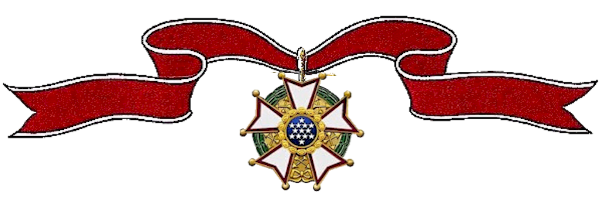The President of the United States of America takes pleasure in presenting a Gold Star in lieu of a Second Award of the Legion of Merit with Combat “V” to Lieutenant Commander (MC) Chester M. Lessenden, Jr. (NSN: 0-154480), United States Navy, for exceptionally meritorious conduct in the performance of outstanding services to the Government of the United States as Regimental Surgeon of the Fifth Marines, FIRST Marine Division, in action against the enemy in Korea from 27 November 1950 to 5 December 1950. Lieutenant Commander Lessenden displayed outstanding professional skill, initiative, and courage during this extremely difficult period of operations under adverse conditions of weather and almost constant contact with a numerically superior enemy. On the night of 27 November, the regiment was subjected to vicious attack, and the heavy influx of casualties soon over-taxed the regimental aid facilities, and the route of evacuation to the rear was closed by enemy action. Throughout the night, he personally directed the reception and treatment of casualties, despite the fact that the air station was subjected to intense and accurate enemy fire. On the following day, the aid station of another friendly regiment was consolidated with him under his command, and by evening approximately five hundred casualties were being treated and held under his supervision in an open field, with evacuation impossible. In the face of sub-zero weather and continuous enemy attack, casualties continued to pour into the aid station, and the enemy at times approached to within a few hundred yards of the area. Meeting these problems with calm assurance, he rendered skillful treatment to the casualties, and directed the improvising of shelter, employing all available medical personnel and even ambulatory patients to assure that each patient was either in a heated space, or at least under cover. He remained on duty continuously for two days and three nights, inspiring the personnel under his command with his unswerving devotion to duty and competence, despite nearing exhaustion. When on 30 November it was decided to commence the withdrawal of the two regiments, he personally arranged and controlled the removal of his approximately seven hundred patients to a selected area approximately thirteen miles to the rear, employing ambulances and a few small trucks, at the time screening the patients for the evacuation of eighty-one more serious cases by helicopter. During the further withdrawal to Hagaru-ri, when all vehicles other than ambulances were needed for the transportation of combat supplies, he directed the loading of nearly four hundred bed-patients into small trucks, vans, and trailers, and continually patrolled the column of vehicles to personally check the condition and welfare of each casualty. His exceptional foresight and constant attention to patients resulted in an amazingly low mortality rate during the difficult two-day fighting withdrawal. On more than one occasion he calmly exposed himself to enemy mortar and small arms fire to care for his patients. Upon arrival at Hagaru-ri, where two medical companies had been established to receive casualties, he persisted in supervising the unloading of his charges, seeking aid for his painfully frost-bitten feet only after he had personally checked the condition of each man. Lieutenant Commander Lessenden’s skilled service, courageous devotion to duty, and exemplary conduct throughout this period were in keeping with the highest traditions of the United States Naval Service. (Lieutenant Commander Lessenden is authorized to wear the Combat “V”.)

Awards Received
-

Legion of Merit
-
Legion of Merit
Service:
United States NavyRank:
Lieutenant Commander (MC)Regiment:
5th MarinesDivision:
1st Marine Division (Rein.)Action Date:
August 21 – September 30, 1950
Commanding General, 1st Marine Division (Reinforced) FMF: Serial 17930 (November 18, 1950)The President of the United States of America takes pleasure in presenting the Legion of Merit with Combat “V” to Lieutenant Commander (MC) Chester M. Lessenden, Jr. (NSN: 0-154480), United States Navy, for exceptionally meritorious conduct in the performance of outstanding services to the Government of the United States as Regimental Surgeon of the Fifth Marines, FIRST Marine Division, during the period 21 August to 30 September 1950. Having had no previous service with Marines, Lieutenant Commander Lessenden joined the Fifth Marines on 21 August 1950 and was assigned duty as Regimental Surgeon on 28 August 1950. The regiment moved into combat on 3 September 1950 and during the next three days about three hundred sixty casualties were treated and evacuated by the Regimental Aid Station which was acting as a collecting station. During the period 6 September to 15 September he procured medical supplies and planned the medical support for the regiment for the landing at Inchon, Korea. After the landing at Inchon, 15 September 1950, the Regimental Aid Station, again acting as a collecting station, handled over one thousand casualties. Lieutenant Commander Lessenden personally attended each of these patients. From 15 September to 23 September 1950, he was the only medical officer in the aid station. During this period about four hundred fifty casualties were evacuated through the aid station. Lieutenant Commander Lessenden’s rapid adjustment to a new and difficult task, and his inspiring example of untiring devotion to his patients were directly instrumental in the rapid treatment and evacuation of each casualty. His skilled service and exemplary conduct throughout this period was in keeping with the highest traditions of the United States Naval Service. (Lieutenant Commander Lessenden is authorized to wear the Combat “V”.)

